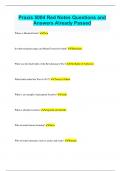Summary
Summary of notes for Political Communication and Journalism Exam
- Module
- Institution
This summary includes all relevant material for the Political Communication and Journalism exam, including notes from lectures and literature provided for the course.
[Show more]












